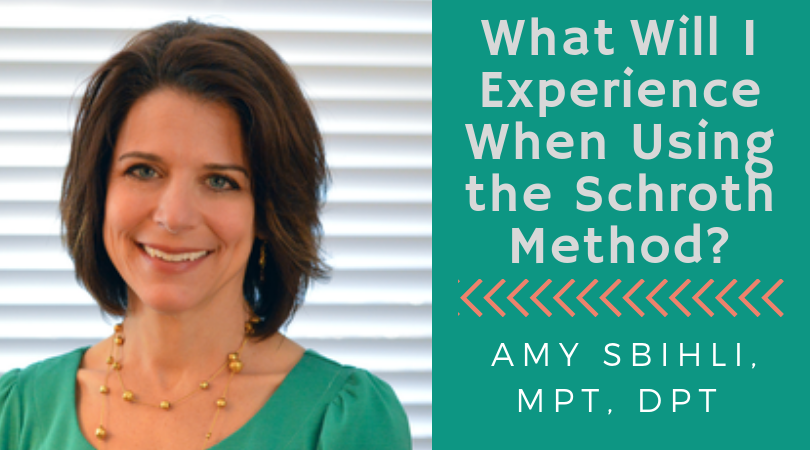What Will I Experience When Using the Schroth Method for Scoliosis?
Posted on by Amy Sbihli, MPT, DPT
During the initial evaluation for the Schroth Method, many patients ask what they will experience during the program. As with all other methods and types of physical therapy intervention, each patient should have a program that caters to their specific needs.
 The Schroth Method is intended to be used by the patient for life, with the frequency and duration decided on a case by case basis. Below are three example cases and the recommended home programs.
The Schroth Method is intended to be used by the patient for life, with the frequency and duration decided on a case by case basis. Below are three example cases and the recommended home programs.
Case A
Background
A mom brings her 9-year-old daughter, Tia, to PT for evaluation. She reports that during a well-check, Tia’s pediatrician noticed a very slight curve in Tia’s spine. An X-ray showed that Tia had a 9-degree spinal curvature. Tia’s mom and grandmother also have scoliosis. Tia’s mother wants to do the Schroth Method because she read about it online. The pediatrician wrote a prescription for PT.
Example Program
In a case like Tia’s, a full evaluation would be done to collect all of Tia’s current values of height, flexibility, strength, and observation of posture and body mechanics for her typical activities and gym class. Development and education for a home exercise program could take 2-4 visits in a 1-4 week time frame. The home program might take 15 minutes, 3 times per week.
Tia would need to be screened within 6 months of the PT evaluation. At this follow-up, a new plan of care may be created depending on the findings of the re-evaluation. As you might notice, the Schroth Method was not introduced at the initial evaluation. This is because we cannot predict if Tia’s curve will progress in severity with the amount of information that we have at this first X-ray. A Schroth Method trained physical therapist knows how much exercise to prescribe based on the clinical and radiological findings. Additionally, they know what exercises are safe to prescribe during this observation period. It is important that the proper amount of work prescribed to the patient matches the patients needs to avoid over-treatment and patient burnout.
Case B
Background
Mark is 14 years old and has been growing rapidly. His dad noticed that his posture seemed different but did not know if that was just normal for a tall teenage boy. At a middle school screening, the school nurse noticed a curvature in Mark’s spine. She recommended a visit to the pediatrician, which was followed by a referral to an orthopedist for scoliosis X-rays. The X-ray report showed that Mark had a lot of growing left in his growth plates and his spine had a 30-degree curvature. It was recommended that Mark initiate full-time rigid bracing and visit PT. When his family learned about the Schroth Method, they found a certified PT and went for an evaluation.
Example Program
In a case like Mark’s, the patient would receive a full-body evaluation followed by an explanation of what the Schroth Method is, what the protocol of treatment is, and what the patient’s responsibilities should be. The patient would be told that once he has been trained, he will be expected to perform his at-home exercise program 5-6 days per week, with each session taking 30 minutes.
If the patient feels like he is ready to proceed with these parameters, treatment for the program can take anywhere from 12-30 hours of training for independence and self -progression capabilities. The patient can also enter into a group exercise program to fine-tune different skills and progress in a collaborative environment. Typically there are follow-up visits until the child has attained full growth and is fully weaned from the brace.
Case C
Background
The patient is a 40-year-old female with children ages 8, 5, and 3 years old. She has known of her scoliosis since she was a teenager. She was braced until she was done growing and has had no trouble until recently when she joined a group exercise class after years of not having time to exercise. She found that when she tries to exercise, she tends to get injured and has to stop and rest. She said, “It is hard to get into shape when I cannot keep a steady routine, so I am here to learn if these exercises will help me feel strong and not hurt me.”
Example Program
An example program might be 10-15 PT visits over 3 months. The home program might include every other day Schroth exercise for 20-30 minutes, education on how to manage flexibility, strength, posture and mechanics at home, work and during her group classes.
If you have questions you can reach Amy at amy@spineacademypt.com.
Amy Sbihli is the Founder and Director of Spine Academy Physical Therapy, PLLC in the Boston area. She is the co-founder of Schroth-Barcelona Institute and an active member of Barcelona Scoliosis Physical Therapy School and SOSORT International education committee. She began working with outpatient orthopedic spine and scoliosis patients in 2004. Amy is certified to practice and teach the Schroth Method through the Barcelona Scoliosis Physical Therapy School (BSPTS) earning her certification in 2005 from the Barcelona Scoliosis Physical Therapy School. Amy received Masters and Doctorate degrees in physical therapy from Washington University in St Louis. She also holds a BA in Kinesiology from the University of Michigan. Treatment expertise includes scoliosis, SI, orthopedic spine, movement dysfunction, and Pilates.

